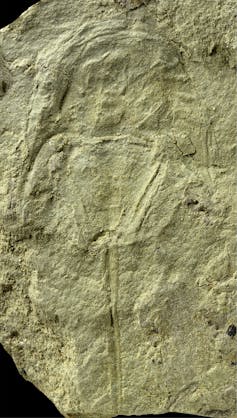We discovered a new fossil species of horseshoe crab (and named it after David Attenborough)
- Written by Russell Dean Christopher Bicknell, Post-doctoral researcher in Palaeobiology, University of New England
There are only four known species of horseshoe crabs alive today. But the fossil record shows that hundreds of millions of years ago they came in a huge range of shapes and sizes.
In our research, published today in the open-access journal PeerJ, we describe one of these extinct species — Attenborolimulus superspinosus — for the first time.
We named this fossil crab after the famous naturalist and documentary host Sir David Attenborough, in honour of his contributions to conservation and science communication.
When life peaked for horseshoe crabs
Today’s horseshoe crabs live along the east coast of North America, as well as the coasts of China, India, Indonesia and Japan. But despite this distribution, the four species are only minutely different from each other.
During the Triassic period, however, between 250 million and 200 million years ago, a whole host of bizarre horseshoe crabs had evolved. We call these austrolimulids.
They lived alongside horseshoe crabs that look broadly similar to limulids — the curious critters we see along the beaches of the United States and Asia today.
The concurrence of two major horseshoe crab groups reflected a recovery from the end-Permian extinction. This event defined the end of the Paleozoic and the beginning of the Triassic, and 95% of marine organisms died out during it!
The newly described animal in our study comes from the early part of the Middle Triassic. We think Attenborolimulus superspinosus lived in marginal marine to freshwater conditions. This is in contrast with modern horseshoe crabs, which are almost exclusively marine animals.
Read more: Ancient marvels: the first shell-crushing predators ground up their prey between their legs
A new austrolimulid from Russia
During research trips to the Ural Mountains of Russia that spanned 2018 and 2019, a team of Russian fossil collectors, palaeontologists and geologists collected fossils from a rock section thought to represent a Triassic-aged floodplain.
One particular group of fossil-rich rocks had preserved a host of animals, including the very rare specimens we examined and published on today.
 A fossil of the newly described species.
A fossil of the newly described species.
Attenborolimulus superspinosus is a unique austrolimulid as it has very developed spines on its head section (called “genal spines”), but notably rounded and somewhat reduced spines on other sections of its segmented body.
This condition of overdeveloping and reducing spines, as well as other body sections, is observed in other austrolimulids. However, the combination of spine size, shape and structure in the new material was unique enough to warrant a new genus and species.
Attenborolimulus superspinosus was over an order of magnitude smaller than modern horseshoe crabs. It was likely a bottom-dwelling organism that fed on whatever it could get into its mouth, which is effectively how modern horseshoe crabs feed today.
What’s rather interesting about some of the fossils we studied is evidence of worms and other arthropods having lived on top of the horseshoe crabs. This tells us they may have been hosts for other parts of their ecosystem, effectively becoming “micro-habitats” for other species in the Triassic floodplain.
 The head section of another Attenborolimulus superspinosus specimen.
The head section of another Attenborolimulus superspinosus specimen.
We don’t really know why austrolimulids didn’t make it into modern ecosystems. But the best explanation relates to how the group inhabited conditions that were closer to freshwater than marine (saltwater) environments.
They may have been outmatched by the resilience of other animals that arose as Jurassic ecosystems developed. This would suggest austrolimulids were simply not very well adapted for the ecosystems that flourished during the Jurassic.
In honour of the great naturalist
We named the new genus after Sir David Attenborough, who has influenced generations of people from all walks of life to understand the natural world and the importance of conservation.
This is especially important for horseshoe crabs now, as two of the four living species are considered endangered. And this is due to negative interactions with humans, including habitat modification and harvesting for their blood (which has applications in modern medicine).
Read more: 'Living fossils': we mapped half a billion years of horseshoe crabs to save them from blood harvests
Attenborolimulus superspinosus is one of more than 12 animals named after Sir David Attenborough, who has dedicated his life to helping us appreciate the beauty and vitality of the natural world.
This BBC documentary clip details some of the physical traits and breeding habits of modern horseshoe crabs.Authors: Russell Dean Christopher Bicknell, Post-doctoral researcher in Palaeobiology, University of New England



















